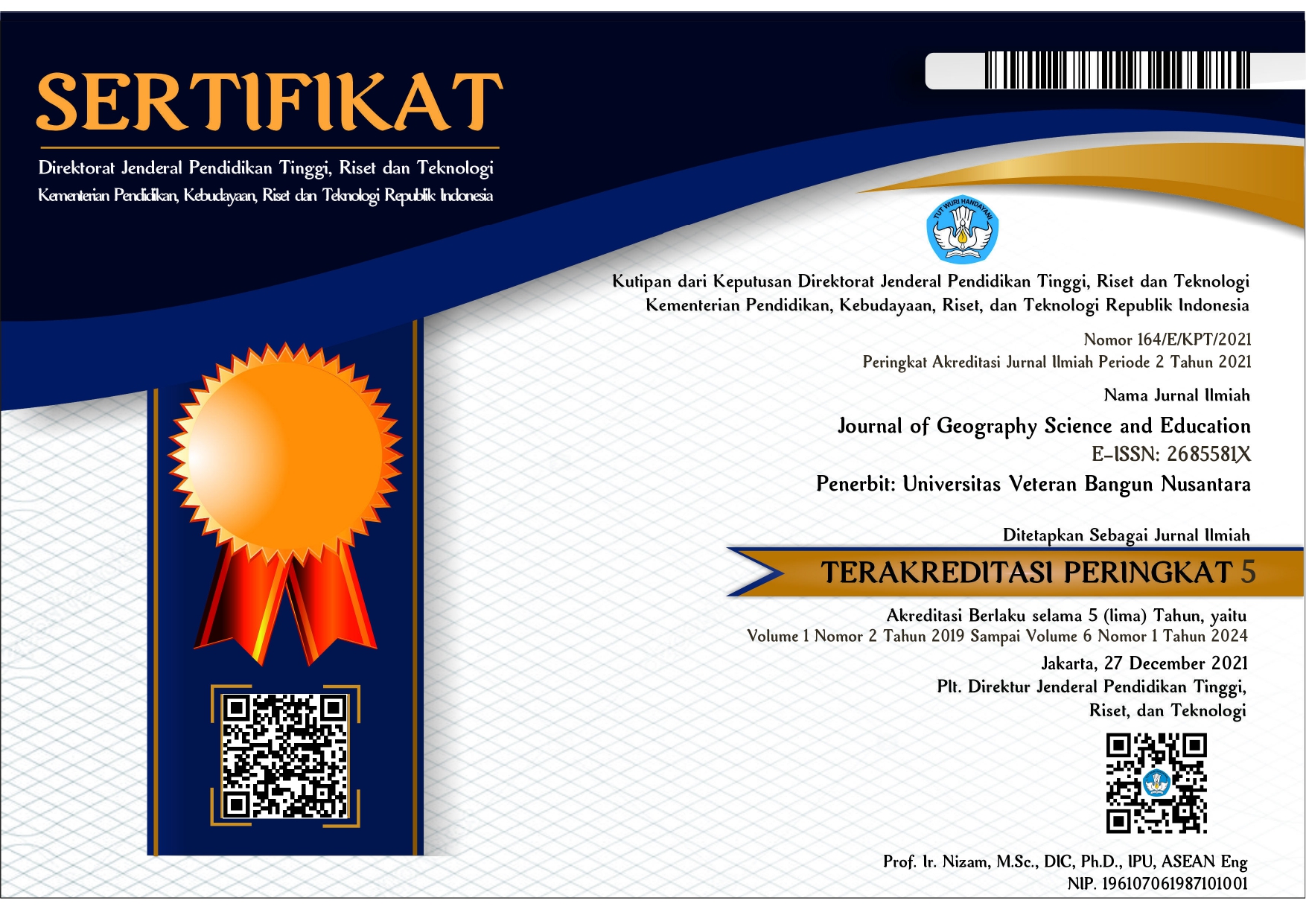Learning Model “AWAS (Activity Watch And See) In Increasing Motivation To Learn Geography In Class XI IPS 1 SMA Negeri 1 Gantung
DOI:
https://doi.org/10.32585/jgse.v4i1.2150Keywords:
Learning Model “ AWAS ( Activity Watch And See ) Motivation to Learn GeographyAbstract
The main problems that will be solved through this Classroom Action Research are: Are The “AWAS (Activity Watch And See)” Learning Model Can Increase Learning Motivation Geography In Class XI 1 IPS SMA NEGERI 1 GANTUNG for the 2020/2021 academic year. The "AWAS (Activity Watch And See)" learning model was chosen with the assumption that it is very relevant to environmental subject matter, with the aim of being able to motivate students to be active, innovative, creative, effective and fun, as well as easy to manufacture and use.The goal to be achieved is to increase student learning motivation in the subject of Geography. The research subjects were students of class XI IPS 1 at SMA Negeri 1 Gantung, totaling 21 students. Research data were collected through daily observations and tests. Sources of data obtained from teachers, peers and students. The action hypothesis is UseThe "AWAS (Activity Watch And See)" Learning Model Can Increase Motivation to Learn Geography in Class XI 1 Social Studies at SMA Negeri 1 Gantung for the 2020/2021 Academic Year. The results showed that the use of the "AWAS" learning model in subjects in Geography on basic environmental competencies could increase students' learning motivation in class XI IPS 1 SMA Negeri 1 Gantung. This is evident from the learning achievement test data also shows an increase, namely in the pre-cycle as many as 11 students (47.6%) achieved the KKM with an average of 75.76, in the first cycle students who achieved completion were 61, 9% or 13 students. with an average of 76.57 and in the second cycle of 85.7% or 18 students with an average of 79.90.So after the whole cycle is done, it can be concluded that the use of The "AWAS (Activity Watch And See)" Learning Model Can Increase Learning Motivation Geography In Class XI 1 Social Sciences at SMA Negeri 1 for the 2020/2021 academic year. The obstacles faced in this AWAS learning are the lack of time allocation, the lack of mastery of using the Windows Movie Maker application (other applications). However, this obstacle can be anticipated by using a powerpoint that is already familiar to studentsDownloads
References
Ali. Muhammad. 1996. Teachers in the Teaching and Learning Process. Bandung: The New Rays of Algesindon .
Arikunto. Suharsimi. 1993. Humane Teaching Management. Jakarta: Rineksa Cipta
Arikunto. Suharsimi. 2001. Fundamentals of Educational Evaluation. Jakarta: Earth Literacy
Arikunto. Suharsimi. 2002. Research Procedure A Practical Approach. Jakarta: Reneksa Cipta.
Azhar. Then Muhammad. 1993. Educational Teaching and Learning Process. Jakarta: National Effort.
Daroeso. Bambang. 1989. Basics and Concepts of Pancasila Moral Education. Semarang: Various Knowledge.
Djamarah. Syaiful Bahri. 2002. Teaching and Learning Strategy. Jakarta: Rineksa Putra.
Djamarah. Syaiful Bahri. 2002. psychology of learning. Reneksa Putra.
Felder. Richard M. 1994. Cooperative Learning In The Technical Corse, (online), (PclldMy% DocumentCoop % 20 Report.
Hadi. Sutrisno. 1982. research methodology, volume I.yogayakarta: yp. Fac. UGM Psychology.
Hamalik. Omar. 2002. Psychology of Learning and Teaching. Bandung: The New Light of Algesindo
Hasibuan. JJ. and Moerdjiono. 1998. Teaching and Learning Process. Bandung: Rosdakarya Youth.
Hasan, Helmi, Montesori and friends, 2003, Teaching and Learning Strategy, Padang, FIS UNP
Margono. 1997. Educational Research Methodology. Jakarta: Reneksa Cipta.
Masriyah. 1999. Analysis of Test Items. Surabaya: Universiats Press.
Ngalim. Purwanto M. 1990. Educational Psychology. Bandung: PT. Rosdakarya Youth.
Nur. Moh. 2001. Motivating Students To Learn. Surabaya. University Press.
Srabaya State University.
Nur. Muhammad. 1996. Cooperative Learning. Surabaya State University.
Riduwan. 2005. Easy Learning Research For Teachers–Employees and Beginners Researchers. Bandung: Alphabeta.
Rustiyah. NK1991. Teaching and Learning Strategy. Jakarta Building Literacy.
Sardiman. AM 1996. Teaching and Learning Interaction and Motivation. Jakarta: Literacy Development.
Soekamto. Toeti. 1997. Learning Theory and Learning Models. Jakarta: PAU-PPAI, Open University.
Soetomo. 1993. Basics of Teaching and Learning Interaction. Surabaya National Business.
Sudjana. N and Abraham. 1989. Research and Educational Assessment. Bandung: New Rays.
Sudjana. 1996. Statistical Methods. Bandung: Tarsito.
Sucahyono and Haryono, 2008. Learning Resources and Learning Media, Malang PPPPTK PKN and IPS.
Sukidine et al. 2002. Classroom Action Research Management. Surabaya: Insane Scholar.
Sukmadinata. Nana Syaodih. 2005. Educational Research Methods. Bandung: PT. Rosdakarya Youth.
Surakhamad. Winarno. 1990. National Teaching Methods. Bandung: Jemmas.
Suryosubroto. B. 1997. Teaching and Learning Process in Schools. Jakarta: PT. Reneksa Cipta.
Shah. Muhibbin. 1995. Educational Psychology, A New Approach, Bandung: Rosdakarya Youth.
Usman. Moh. Uzers. 2001. Becoming a Professional Teacher. Bandung: Rosdakarya Youth.
Downloads
Published
How to Cite
Issue
Section
License
Authors who publish with the Journal of Geography Science and Education agree to the following terms:
- Authors retain copyright and grant the journal the right of first publication with the work simultaneously licensed under a Creative Commons Attribution License (CC BY-SA 4.0) that allows others to share the work with an acknowledgment of the work's authorship and initial publication in this journal.
- Authors are able to enter into separate, additional contractual arrangements for the non-exclusive distribution of the journal's published version of the work (e.g., post it to an institutional repository or publish it in a book), with an acknowledgment of its initial publication in this journal.
- Authors are permitted and encouraged to post their work online (e.g., in institutional repositories or on their website) prior to and during the submission process, as it can lead to productive exchanges, as well as earlier and greater citation of published work.










